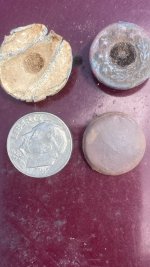GL
Bronze Member
LINKRED RIVER GORGE — On a flat, grassy piece of land beside the Red River, a man sat in the shade, striking a piece of wood against a rock, slowly shaping a rough piece of flint into a spear point.
Because he had done this many times before, the man knew just where to hit the flint to produce a strong, thin point that could easily pierce an animal's hide and sink into a vital organ.
The scene could have taken place on the same spot thousands of years ago, but it happened last week.
The man was wearing a T-shirt, green Forest Service uniform pants, and, in a radical meeting of ancient and modern technologies, a microphone that sent signals to a high-definition digital video camera.
He is Johnny Faulkner, an archaeological technician for the Daniel Boone National Forest and the moving force behind the 20th annual Living Archaeology Weekend coming Friday and Saturday.
Faulkner is, among his many skills, a flint-knapper.
He is one of a small group — perhaps 50 in Kentucky do it well — who practice an art that once was commonplace.
"People were knapping here 12,000 years ago," he said as the pile of flint chips at his feet grew. "It was such a common technology that kids, women, men — they all were flint-knapping. Women would have a piece of rock and they could knock off a simple flake if they needed to scrape a hide."
He explains his technique as he works. A rock, a piece of wood or an antler is used to knock off flint chips in a process called percussion knapping.
Then the pointed tine of an antler can be used to push off smaller flakes. That's pressure knapping.
He regularly pauses and rubs a rock along a sharp edge. That strengthens the edge, which makes it easier for a strong blow to take off a long, thin flake. Thin and symmetrical are the flint-knappers' goals.
Faulkner's skills are well-honed; he has been knapping for 25 of his 54 years.
He grew up on a farm near Clay City, a short way down the Red River from the gorge.
His points look so authentic that he has been commissioned by museums to make them for public exhibits.
As a boy, he worked in tobacco fields and became fascinated by the spear points and arrowheads he found there. (The bow and arrow were late-comers in Kentucky, arriving about A.D. 600 to 700.)
Faulkner started working for the Forest Service 30 years ago, and spent some time on the Red River Gorge Rescue Squad.
Then he got interested in archaeology and in trying to better understand the prehistoric people of the area by learning some of the skills they needed to survive in a world before brick homes and supermarkets.
He knows how to make a house out of bent saplings. He gathers beans from his garden in a basket covered with tree bark. He has brought down a deer with a bow and arrow he made himself.
Flint-knapping, he said, is a natural part of helping understand an archaeological site: A boulder at the edge of an overhanging rock shelter, in good light, with a pile of flint chips at its base — he can practically see the Native American knapper at work.
And, like other knappers and archaeologists, Faulkner believes he can identify the work of specific knappers who lived and died thousands of years ago, especially when the points are found in the same area of the state.
"It gives us an insight that there were folks in prehistory ... who were highly skilled in it, and probably did it for a living," he said.
Modern knappers might also recognize one another's work, but they are likely to see it on the Internet, or at one of the "knap-ins" held around the country.
Although there are only a few knappers in Kentucky, there are thousands in the West.
Some knappers are archaeologists, Faulkner said, but most are just people interested in the ancient art.
Some sign their work with a small diamond drill bit to show that they are not prehistoric points. But there have been cases, Faulkner said, where unscrupulous people have used lye or other chemicals to "booger up" new points, giving them a patina that makes them look old and considerably more valuable.
Knapping alongside Faulkner in the gorge last week was Ronnie Hazlett II, who graduated from the University of Kentucky late in 2006 with degrees in history and classics.
Hazlett is 28 and represents a new generation of knappers. Hazlett has been knapping for six years and lays out his history and other knapping information on www.ken-tuckyknappers.com.
Hazlett's long-range goals involve law school, but for now he has a job at the Kentucky Archaeological Survey.
His job there fits in well with his knapping: He analyzes debitage — the chips found at archaeological sites that show someone had been making points there.
Faulkner has won two Forest Service awards in his two decades of work with the Living Archaeology Weekends. But the one coming up will be his last as a Forest Service employee.
He says he probably will be back, this time as a paid presenter, demonstrating flint-knapping or some other skill that once was common in Kentucky but now is very rare.


 (Sorry if its an old joke. Couldn't resist.)
(Sorry if its an old joke. Couldn't resist.)

